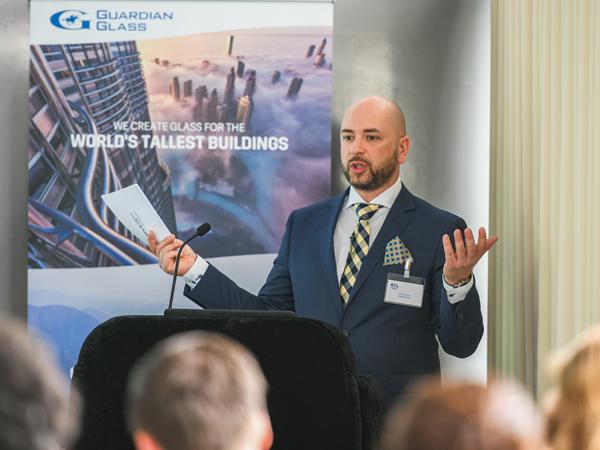Glass for megatall buildings (i.e. skyscrapers over 600 metres high) often tends to be taken for granted in terms of its technical functions. Yet the high-tech, high strength glazing that covers today’s megatall buildings – such as the Burj Khalifa in Dubai – is as important to the building’s performance as the steel and concrete inside it.
When it comes to megatall structures, the main challenges are wind loads, temperature and altitude differences, and condensation.
Close to the ground, wind is disrupted by trees and other buildings, but as a building rises to supertall heights, these obstacles disappear. The tower then faces the full, unobstructed force of the wind.
Other major factors are light and heat. Tall buildings, because of their enormous internal heat mass, tend to need constant air conditioning, even in the colder months of the year. Air conditioning is a skyscraper’s single biggest energy cost. Megatall buildings present a unique challenge: not only do they have high internal heat mass, but a very large proportion of their overall size is high above their neighbours, so there’s nothing to block the sun. Also, most of them tend to be in desert regions of The Middle East, Africa and South East Asia.
To complicate matters further, the skin of megatall buildings is now almost entirely glass, with a premium placed on tall and wide glass panes to offer maximum unobstructed views. The challenge is, these larger glass panes must be extremely strong to withstand the high wind forces, and must be designed in such a way to compensate for the huge amount of light they let in to the building in order to enhance the wellbeing and comfort of the building’s occupants.
Challenges specific to megatall buildings
The surroundings
The surroundings of a building – and, in the case of the Burj Khalifa and the Jeddah Tower, the local desert climate – are important factors to consider. The surrounding areas of megatall buildings such as the hills and other buildings, actually absorb much of the intense heat during the day but continue to radiate or emit this heat to their surroundings through the night. Low-emissivity (Low-E) glass helps to reflect this long wave radiation and minimise its transmission. This is why the use of Low-E glass (such as Guardian SunGuard Neutral 60) is one of the best choices.
The local climate in these hot, humid, desert regions – with daytime temperatures reaching as high as 50°C – pose real challenges for the glass in terms of both stress and deflection, but also potential condensation issues.
Most people don’t realise how popular Low-E glass is in the Middle East and why it should be used. Generally, people think Low-E glass is only used in cold weather climates. However, the concept of blocking and reflecting indirect heat at night and during the daytime is something most people wouldn’t consider.
Condensation
With megatall buildings, there is always a risk that condensation may appear on the external glass pane (outside). This is due to the temperature difference between the outside of the building (which is very hot and humid during the summer) and the inside temperature (air conditioning).
Using a low-emissivity glass as the internal pane may help to prevent the cold transferring from the inside of the building to the outside glass pane, while heat treatment (fully tempering or heat strengthening) will make the glass up to 5 times stronger to resist extreme wind loads and temperature differences.
Altitude differences
The altitude difference between the top and the bottom of a megatall building – and the temperature difference linked to this – can cause glass deflection issues on the insulating glass unit due to the pressure difference.
On the Burj Khalifa project, there was even the challenge of the temperature difference between the production and installation temperatures of the IGUs, which were manufactured in January with a temperature of 26°C, and then installed on site in Dubai in August when the temperature was 48°C. The calculations of stress and deflection of the IGUs enabled our technical experts at Guardian Glass to help define the right glass thicknesses to suit different glass installation heights up and down the building.
Wind
Due to the height of megatall buildings, wind forces can be extremely high. Even though the dynamic shape of the building is designed to reduce structural loading due to wind vortex shedding, the glass thickness is very important too. For the Burj Khalifa, the glass façade was designed to withstand wind loads of up to 250 km/hour.
As I mentioned earlier, the glass system for the Jeddah Tower is designed to withstand a 2.5 metre radius sway without breakage or leakage. The thickness of the glass used depends on the height of the building where it is installed. The heat treatment is also crucial (fully tempering or heat strengthening) as it will make the glass up to 5 times stronger to resist extreme wind loads and temperature differences.
You have questions on the use of glass in your next project, whatever its size and location, we will gladly support you.
About the Expert - Jasmin Hodzic
Jasmin Hodzic occupies currently the role of Commercial Project Director for Guardian Glass in Africa and Middle East. In this role, Jasmin is responsible for leading the teams of Architectural Sales Managers and Technical Advisory Experts working closely with all stakeholders in commercial façade business.


















